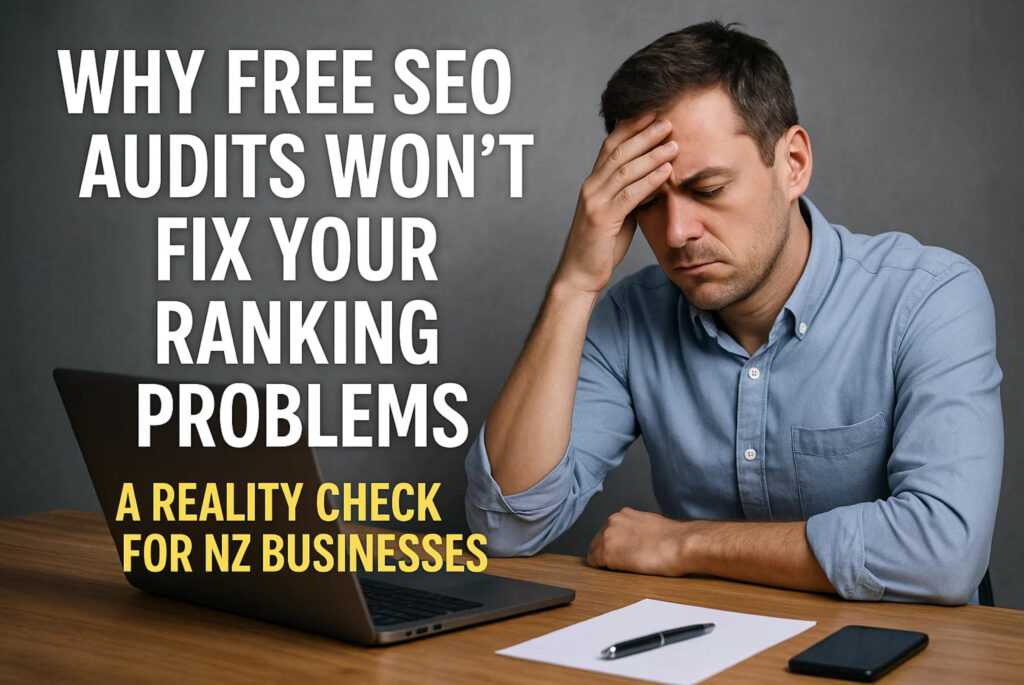
Every week, business owners from Auckland to Dunedin search for a free SEO audit tool, hoping to uncover the secret to their ranking struggles. The appeal is obvious: why pay for professional analysis when automated tools promise to check website SEO for nothing? The uncomfortable truth is that these free tools rarely deliver actionable insights that move the needle on your Google rankings.
After conducting hundreds of comprehensive audits for businesses across New Zealand—from Christchurch tourism operators to Wellington tech startups—I’ve seen firsthand how free audit tools create more confusion than clarity. Let me explain what these tools actually do, why they’re limited, and what genuinely matters for your website’s visibility.
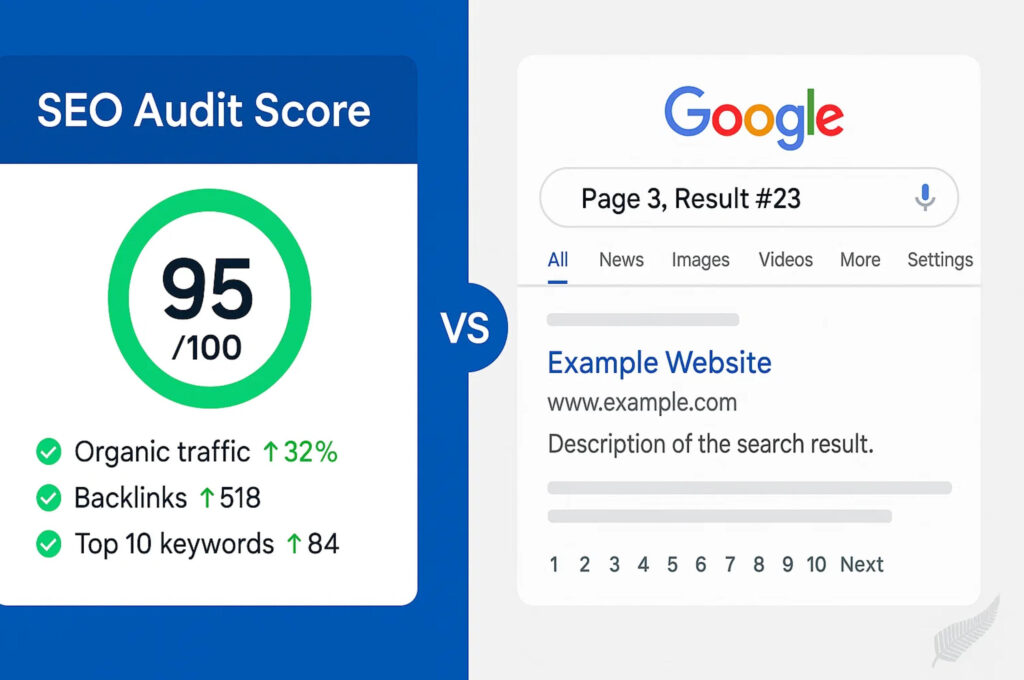
What Free SEO Audit Tools Actually Check
Free website audit tools operate on a simple premise: they crawl your site and measure it against a checklist of basic technical parameters. These automated scans typically examine:
Meta tag presence – Do your pages have title tags and meta descriptions? Are they the right length? These are the basics that any modern CMS like WordPress, Shopify, or Wix handles automatically if you simply fill in the provided fields. A Hamilton retail store using Shopify doesn’t need a tool to tell them their meta descriptions are missing—they need to know why those descriptions aren’t converting clicks.
Image alt text – The tool will flag missing alt attributes, but it can’t tell you whether your alt text actually describes the image meaningfully or if it’s just keyword-stuffed nonsense that provides no value to visually impaired users or search intent.
Page speed metrics – You’ll get a score, perhaps from Google’s own PageSpeed Insights integration, but rarely any context about which speed issues actually matter for your specific audience. A Tauranga hospitality business serving mobile users on patchy rural networks has different priorities than a Dunedin law firm whose clients browse from desktop computers.
Mobile responsiveness – The tool confirms your site works on mobile devices, which has been a non-negotiable requirement since Google’s mobile-first indexing became the default years ago. If you’ve built your site on any platform since 2018, this is already handled.
HTTPS security – You’ll be informed whether your site uses SSL encryption. Again, this has been table stakes since 2014. Every legitimate hosting provider includes this by default now.
The pattern becomes clear: these tools check whether you’ve done the absolute minimum that modern CMS platforms already do for you automatically. They’re measuring whether you’ve left fields blank, not whether you’ve filled them strategically.
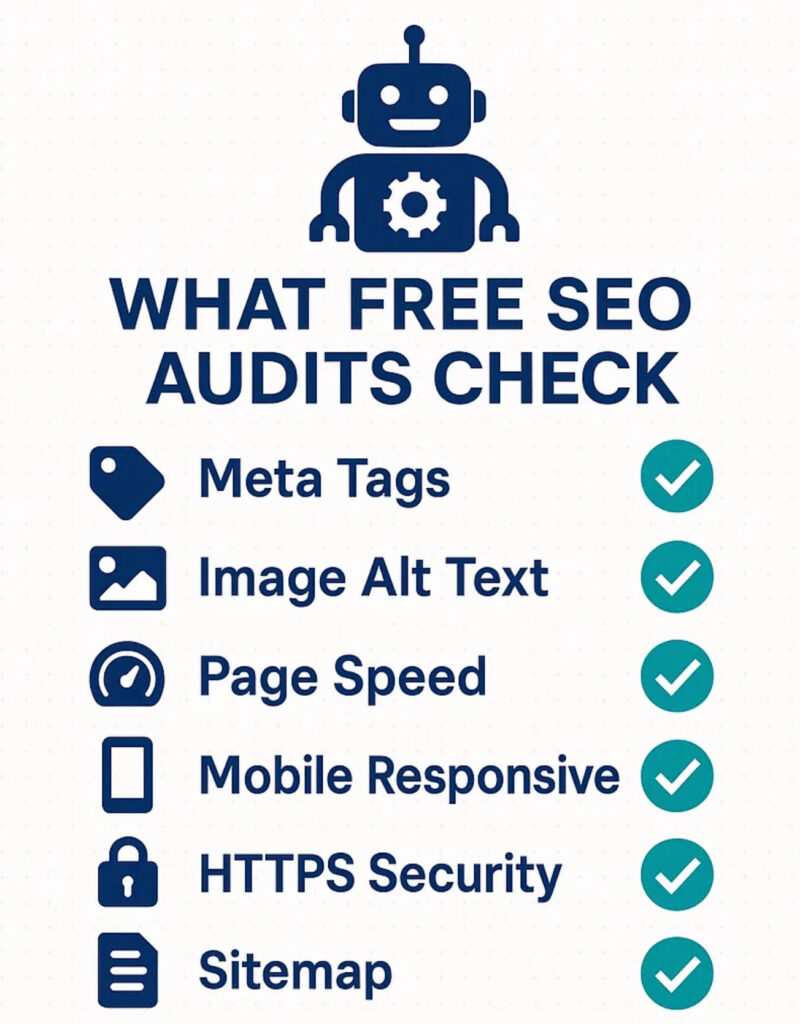
The Critical Issue Free Tools Miss Entirely
Here’s what actually determines whether Google can understand and rank your content: can Google’s crawlers access, render, and interpret your information correctly? This single question encompasses the most critical technical SEO challenges that free audit tools completely overlook.
Consider a real scenario I encountered with a Palmerston North e-commerce business. Their free audit tool gave them a glowing score—green checkmarks across the board. Yet their product pages weren’t ranking. Why? Their site used JavaScript to load product information, and while Google’s crawler could technically execute the JavaScript, the critical content was being loaded after a user interaction event that the crawler never triggered. The page appeared blank to Google, despite looking perfect in a browser.
Free tools can’t simulate how Google’s actual crawler processes your specific implementation of modern web technologies. They don’t test whether your:
- JavaScript framework properly renders content for crawlers or hides it behind user interactions
- Schema markup is actually valid and contextually appropriate, or just copy-pasted templates
- Internal linking structure logically distributes authority to priority pages or scatters it randomly
- Content architecture matches user search intent or merely targets keywords
- Regional targeting aligns with New Zealand search behavior and local terminology
A tourism operator in Auckland might have perfect technical scores but use American spelling and terminology that doesn’t resonate with Kiwi searchers or international tourists researching New Zealand specifically. No automated tool catches this nuance.
Why Modern CMS Platforms Have Changed the Game
Ten years ago, many websites were hand-coded HTML with inconsistent implementation of SEO basics. Back then, an automated tool flagging missing meta tags or broken links provided genuine value. Today’s landscape is fundamentally different.
If you’ve built your site on WordPress, Shopify, Wix, Squarespace, or virtually any modern platform within the past five years, the technical basics are already handled. These systems automatically generate:
- Properly structured HTML with semantic elements
- Mobile-responsive layouts that adapt to any screen size
- XML sitemaps that update automatically
- Canonical tags to prevent duplicate content issues
- Basic Open Graph tags for social sharing
- Clean URL structures without messy parameters
The real SEO work—the work that actually impacts rankings—involves the strategic decisions that no automated tool can make:
Content strategy – What topics should a Christchurch real estate agency write about to capture buyers at different stages of their journey? How should they structure information to match search intent?
Competitive analysis – What are successful competitors doing differently? Why does another Hamilton landscaping business rank first for “garden design Hamilton” when your technical scores are identical?
User experience optimization – How do actual visitors navigate your site? Where do they get stuck or frustrated? What elements build trust and drive conversions?
Link building – Which local organizations, industry publications, and relevant websites should link to your content? How do you earn those links authentically?
These strategic elements determine your visibility far more than whether your images have alt text—a checkbox item that takes five minutes to fix but doesn’t fundamentally change how Google understands your business’s value proposition.
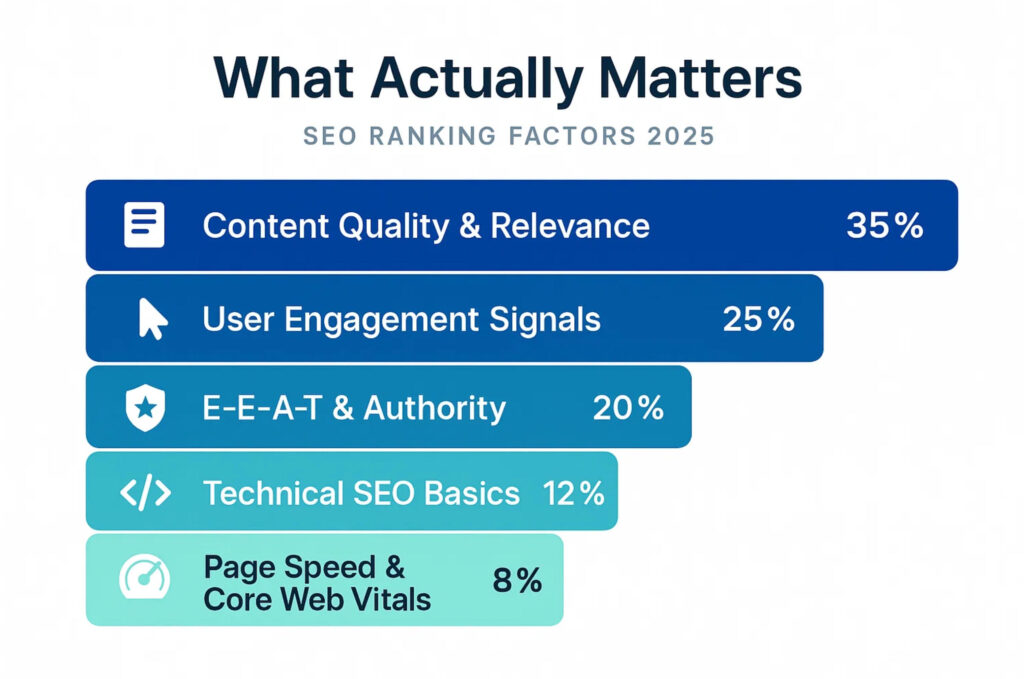
What Actually Moves Rankings in 2025
After conducting manual audits for businesses across every major industry in New Zealand—from dairy cooperatives to SaaS companies, wine tourism to professional services—certain patterns consistently emerge among sites that rank well versus those that struggle.
Google’s ability to understand your content remains paramount, but understanding goes beyond simple crawling. When I audit a Wellington law firm’s website, I’m not checking whether meta descriptions exist—I’m analyzing whether Google can confidently determine that this firm specializes in employment law versus family law, and whether the content demonstrates genuine expertise through case studies, detailed legal analysis, and original insights rather than generic legal information regurgitated from other sites.
Content depth and originality separate winners from also-rans. A Tauranga construction company that publishes generic blog posts about “5 Tips for Kitchen Renovations” won’t outrank competitors who publish detailed project breakdowns showing specific challenges they solved, materials they recommended, and results they delivered—complete with real photos and client testimonials. Google’s algorithms have become remarkably sophisticated at distinguishing between thin, generic content created to rank versus substantive information that genuinely serves user intent.
User engagement signals increasingly influence rankings, though Google will never admit exactly how much weight these carry. When searchers consistently click your result, spend time on your pages, and don’t immediately bounce back to the search results, Google interprets this as confirmation that your content satisfies the query. This is why two Dunedin HVAC companies with identical technical SEO can rank differently—one has compelling title tags and meta descriptions that earn clicks, plus content that keeps visitors engaged.
E-E-A-T (Experience, Expertise, Authoritativeness, Trustworthiness) has become Google’s framework for evaluating content quality, particularly for topics that impact people’s health, finances, or major life decisions. If you operate in healthcare, legal services, financial planning, or similar sectors, demonstrating genuine expertise through author credentials, citations, and comprehensive coverage matters immensely. A free audit tool can’t evaluate whether your content demonstrates experience and expertise—it can only confirm that words exist on the page.
Local SEO factors deserve special attention for businesses serving specific New Zealand markets. Google My Business optimization, consistent NAP (Name, Address, Phone) citations across local directories, locally-relevant content, and genuine reviews from real customers in your area carry significant weight. An Auckland restaurant with perfect technical SEO but no Google My Business listing or local reviews will lose to a competitor with average technical implementation but strong local signals.
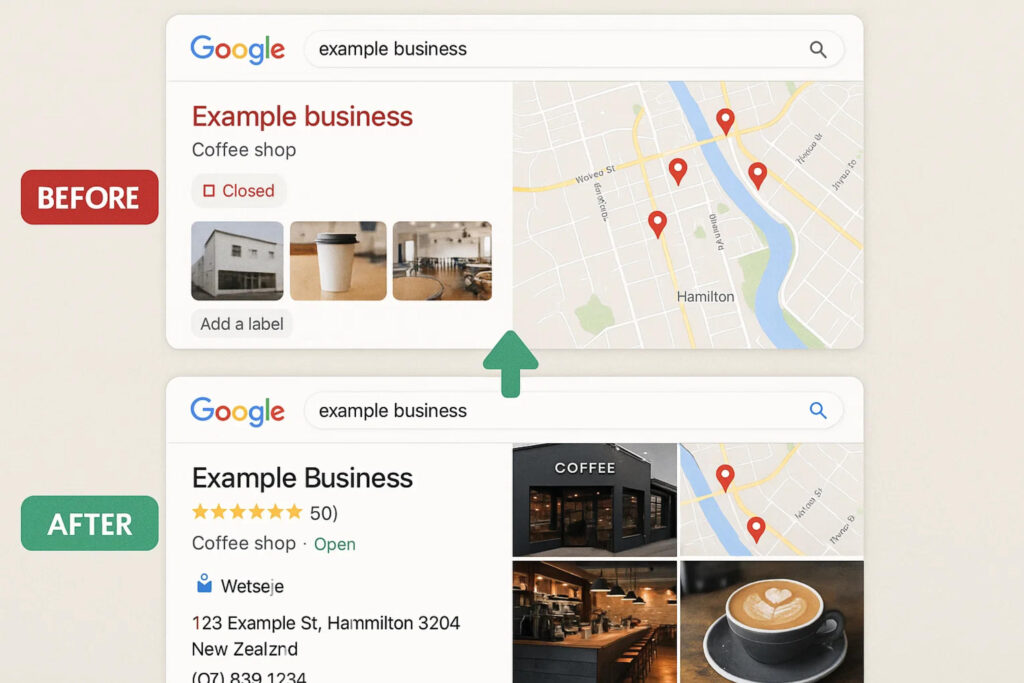
A Real Example: The Café That Scored 95/100 But Didn’t Rank
Let me share a concrete example that illustrates these principles. A café owner in Hamilton ran a free website audit that returned an impressive 95/100 score. The tool praised their fast loading times, mobile responsiveness, proper heading structure, and complete meta tags. Yet they weren’t ranking for “best brunch Hamilton” or similar local searches that should drive customers through their doors.
When I conducted a manual audit, several critical issues emerged that the automated tool completely missed:
Their Google My Business listing used an inconsistent business name compared to their website, creating confusion about whether they were the same entity. The address format differed slightly between the website footer and GMB. These inconsistencies undermined Google’s confidence in their location data.
Their “About” and “Menu” pages contained generic content that could describe any café anywhere. Nothing indicated what made their brunch unique or why someone should choose them over competitors. The free audit tool saw text on the page and checkmarked “content exists”—it couldn’t evaluate whether that content was strategically valuable.
Their schema markup technically validated, but they’d implemented generic Restaurant schema copied from a tutorial. They weren’t marking up their actual menu items, opening hours, or the specific services that differentiated them (locally-sourced ingredients, vegan options, weekend live music).
Internal linking barely existed. Their blog posts about coffee culture and brunch trends never linked to their menu or booking page. Visitors (and Google’s crawler) had no clear path through the site toward conversion actions.
After addressing these strategic issues—not the technical checkboxes the free tool measured—they began ranking on the first page for key local terms within six weeks. The technical foundation was already solid; they’d been optimizing the wrong things.
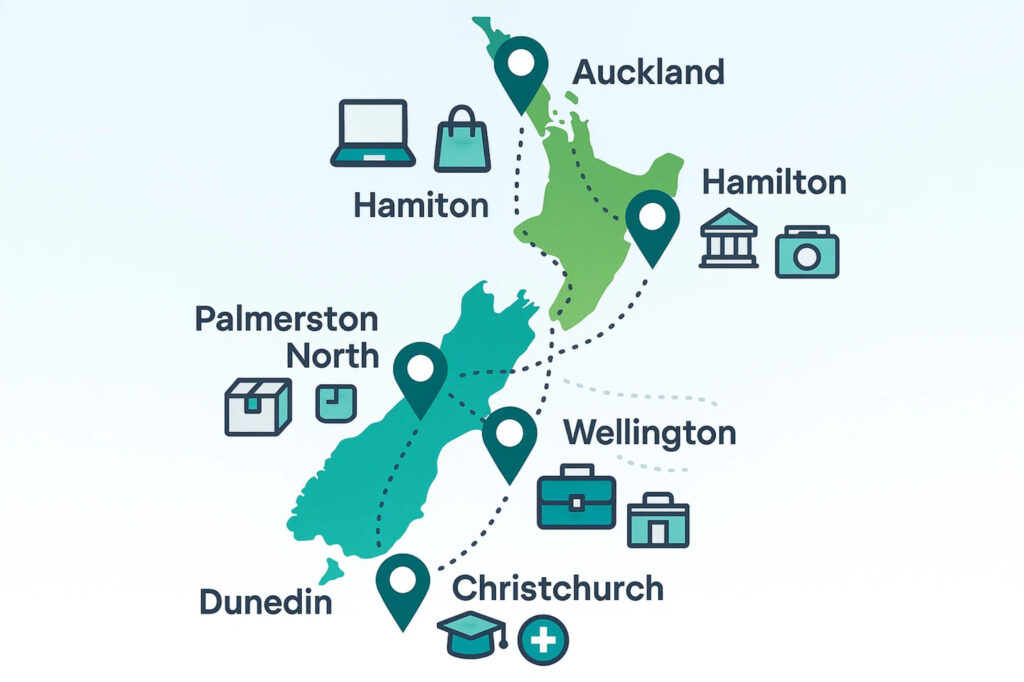
When Free Audits Actually Provide Value
To be fair, free SEO audit tools do serve a legitimate purpose in specific scenarios. They’re genuinely useful when:
You’ve just inherited a neglected website that hasn’t been updated in years and you need to quickly identify glaring technical problems. An old Christchurch manufacturing site built in 2012 might indeed have missing meta tags, broken links, or no mobile optimization. A free scan will flag these immediately.
You need to convince stakeholders that SEO investment is necessary. Sometimes decision-makers need to see that external third-party tool showing red warning flags before they’ll approve budget for professional SEO work. A free audit report can be a useful conversation starter.
You want a second opinion on whether a recent site migration preserved important elements. After moving from one platform to another, a quick automated scan can confirm you didn’t accidentally lose meta tags or create redirect issues.
You’re comparing multiple tools to understand what features you’ll get from a paid SEO platform. Many paid SEO tools offer limited free scans as a preview. These can help you evaluate whether their full platform would suit your needs.
However, even in these situations, the free audit is just a starting point—never the complete picture. Think of it like a car’s dashboard warning light. When the check engine light illuminates, it tells you something requires attention, but it doesn’t tell you whether you need a $50 repair or a $5,000 engine replacement. That requires proper diagnostics from someone with expertise.
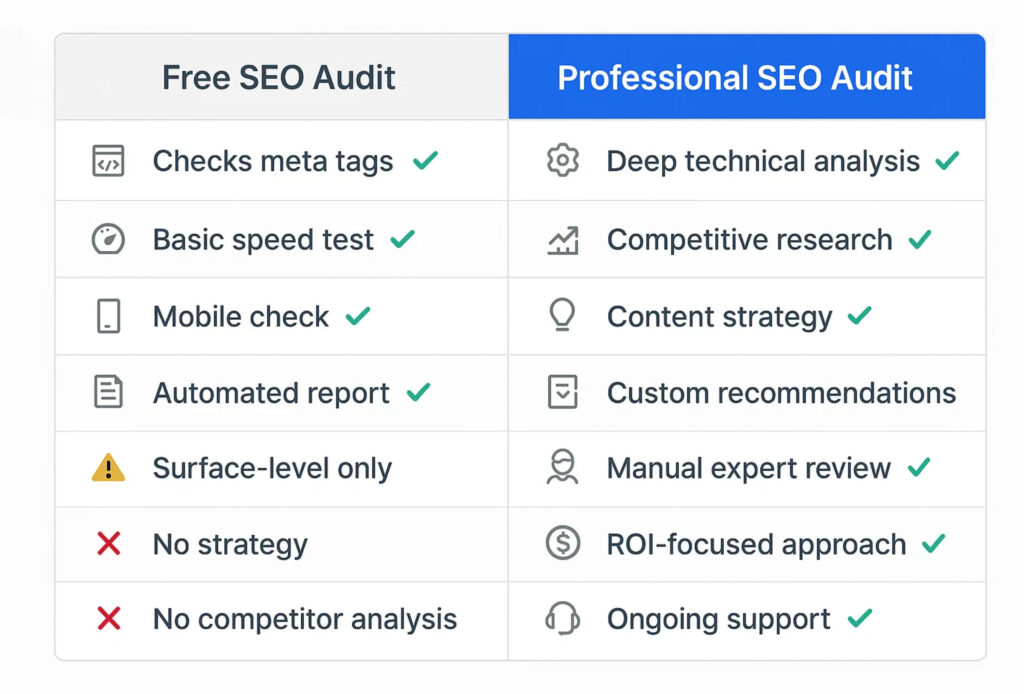
What Professional SEO Analysis Actually Involves
A comprehensive professional website audit examines everything free tools check, but then goes substantially deeper into strategic territory. When I audit a site for a client in Auckland, Wellington, or any New Zealand market, the process includes:
Competitive analysis specific to their market and keywords. I identify the top 5-10 competitors actually ranking for their target terms and analyze what those competitors are doing that my client isn’t. This reveals the actual ranking factors Google is weighing for specific queries in specific locations.
Search intent mapping for every target keyword. Does Google show commercial pages, informational content, or local pack results for this term? If my client’s pages don’t match the intent Google wants to show, no amount of technical optimization will help them rank.
Content gap analysis identifying topics their competitors cover that they don’t, questions their target audience asks that they haven’t answered, and opportunities to create more comprehensive resources than currently exist.
Crawl budget and indexation analysis using tools like Google Search Console to understand which pages Google is actually crawling, how frequently, and whether any important content is being ignored or blocked.
Technical implementation review of their specific CMS, plugins, JavaScript frameworks, and third-party integrations to ensure everything works harmoniously and doesn’t inadvertently harm SEO. This includes testing how Google’s actual crawler sees their pages, not just how they appear in a browser.
Conversion optimization examining whether the site effectively moves visitors toward business goals. A page that ranks first but converts poorly needs UX improvements, not more SEO.
Link profile analysis reviewing both inbound links and internal linking structure to understand how authority flows through the site and whether any harmful links need addressing.
This type of analysis requires human judgment, industry knowledge, and strategic thinking that no automated tool can replicate. It’s the difference between knowing your cholesterol number and understanding what dietary and lifestyle changes will actually improve your cardiovascular health.

The Bottom Line for NZ Business Owners
If you operate a retail store in Dunedin, run a tourism business in Auckland, manage a professional services firm in Wellington, or own any business that depends on local customers finding you online, here’s what you need to understand:
Free SEO audits are not inherently bad—they’re just limited. They’ll confirm you’ve checked the basic boxes that modern websites should already handle automatically. They won’t tell you why you’re not ranking, what your competitors are doing better, or how to improve.
The real SEO work happens at the strategic level: understanding search intent, creating genuinely valuable content, building authority through links and reputation, optimizing for conversions, and ensuring Google can properly interpret your content’s meaning and relevance.
Modern CMS platforms have already solved the technical issues that free audits obsess over. If you built your site recently on WordPress, Shopify, or similar platforms, you don’t need a tool to tell you whether you have meta tags—you need expertise to optimize what goes in those tags.
The most critical check is whether Google can actually read and understand your content as you intended. This requires testing with real crawlers, analyzing how your JavaScript renders, verifying your schema markup provides accurate context, and confirming your information architecture makes sense to both users and algorithms.
When you’re ready to move beyond checkboxes and actually improve your rankings, invest in professional SEO analysis from someone who understands your market, your competition, and the strategic decisions that influence visibility. A comprehensive audit from an experienced professional costs more than a free automated scan, but it’s the difference between knowing your website has problems and knowing exactly how to fix them.
The businesses across Hamilton, Tauranga, Palmerston North, and throughout New Zealand that rank well aren’t succeeding because they have perfect audit scores—they’re succeeding because they’ve made strategic decisions about content, user experience, and authority building that align with both user needs and Google’s ranking factors. That’s what genuinely effective SEO looks like in 2025.
